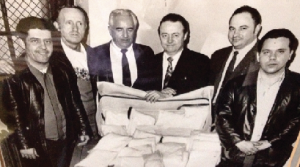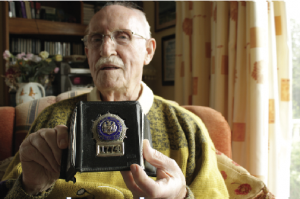Radio Ear
Published in 20th-century / Contemporary History, Issue 6 (November/December 2013), Reviews, Volume 21Peter Daly: good cop/bad cop
‘Documentary on One’, RTÉ Radio 1,
14 September 2013
Citizens: Lockout 1913–2013
Episode 5: ‘Consequences 1914–1916’, RTÉ Radio 1, 7 September 2013
Listening to Peter Daly: good cop/bad cop, it was hard not to feel that the story being told was as fit for the big screen as for a radio documentary. Born in Ballyshannon, Co. Donegal, 80 years ago, Peter Daly would emigrate, like so many young Irishmen of his time. While a career in the New York Police Department was not a particularly unusual path for an Irish emigrant in the United States, Daly’s story would take a major twist when the Donegal man found himself entangled in the ‘100 kilo case’, one of the largest drug busts in American history. Daly was sentenced to ten years in prison for his involvement in a remarkable case of police corruption, where officers personally profited from the drugs trade of the city. Presented by Marc McMenamin, also a native of Ballyshannon, the documentary followed Daly as he returned to New York, attending a reunion with other former police officers.

The ‘100 kilo case’—Peter Daly is second from the left; on the far right is Carl Aguillez, who testified against Daly and to whom he sent the postcard after his flight to Ballyshannon. The heroin in the picture later found its way back onto the streets. (Peter Daly)
Much of the documentary relied on the oral testimony of Daly himself. Unusually for an emigrant of the time, he came from a comfortable middle-class background. Only interested in ‘football, women and dancing’, Daly described his youthful school days as a bit of a lost opportunity, and made the decision to prove himself in New York as a young man of nineteen. The sense of awe and wonder that must have been so common to Irish migrants arriving in the city was captured in Daly’s words, and it didn’t take him long to blend into the American life. In search of employment, he would find himself fighting in the Korean War, returning to New York and achieving US citizenship. A career in the New York Police Department followed, which would lead Daly down a bad path and into public scrutiny. Archival reports from the New York Times were read, informing listeners that Daly was one of twelve police officers accused of stealing cash from narcotics dealers in New York, reselling heroin they had seized in an arrest and offering bribes to fellow officers to hinder persecution of certain drug traffickers. Indeed, Daly himself faced a charge that his personal bank account contained more than $150,000, thirty times more than the annual salary of a New York police officer at the time, though this was eventually thrown out.

Above: Bob Leuci, a member of Daly’s unit but who also worked undercover for Rudolph Giuliani and Joe Jaffe
McMenamin travelled to New York with Daly, attempting to get to the bottom of the story, and recorded interviews with men who had worked alongside him in the force. Not only did McMenamin interview friends of Daly but he also discussed the case with Joseph Jaffe, who, along with Rudolph Giuliani, was central to prosecuting the corrupt policemen. The extent to which the New York authorities suspected corruption within the force is clear from the fact that there were informers working within the police department, including Daly’s own partner, Carl Aguillez. Catching wind of a potential witch-hunt in the force, Daly fled to Ballyshannon, and rather boldly even sent a mocking postcard to his former partner in the New York Police Department! While the lack of an extradition treaty between Ireland and the United States may have kept him safe in Ireland, a visit to the UK to visit relatives proved disastrous, leading to his extradition to the US. In jail he would form friendships with leading Mafia figures, useful in a prison that would see over a dozen homicides in the five years he spent there. Behind him in New York Daly would leave not only a tainted police career but also a wife and children, a family we hear very little about during the documentary. ‘Of course I was dishonest, I’m dishonest now, we’re all dishonest’, Daly tells us in the closing remarks of the production. The documentary was an intriguing insight into the life of a Donegal man initially viewed by the documentary-maker only as a local gent and friendly neighbour but who was revealed to be quite the raconteur and a man of many lives.
Great praise is due to RTÉ for its Citizens: Lockout 1913–2013 series, which examined the 1913 Lockout and its roots, impact and legacy. Many of the themes and issues examined in this series featured in the recent History Ireland special on the 1913 Lockout, and several contributors to that edition of the magazine feature here. Episode 5 examined the consequences of the labour struggle. Diarmaid Ferriter attempted to crack the old chestnut that the Lockout was some kind of precursor to the Easter Rising, sometimes described even as a dress rehearsal. Ferriter argued that the planning of the rebellion was in many ways a minority affair, far removed from the mass movement of the Lockout. Leading Lockout historian Padraig Yeates put forward a similar view, arguing that the actual history of the event has in many ways been lost to a dominant nationalist narrative. Kevin Myers came to the defence of William Martin Murphy on the issue of the Irish Independent’s call for the execution of James Connolly in 1916, arguing that this was not a call made or supported by Murphy. To Myers, he was ‘the prototype of the modern Ireland’, and Myers stressed that he ‘would rather have a world run by William Martin Murphy than James Larkin’. The series drew on important archival material as well as utilising the medium of radio to its full potential, featuring powerful and emotive songs from the period, as well as commanding acting performances. The series sets a high standard for RTÉ Radio’s output during the decade of centenaries ahead. HI
Donal Fallon is co-author of Come here to me: Dublin’s other history (New Island Books, 2012).


















